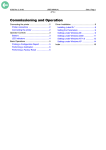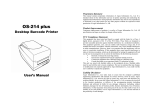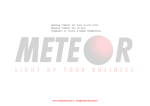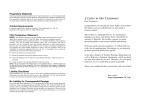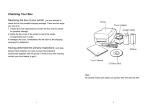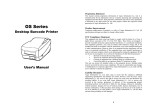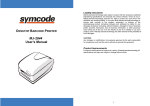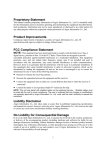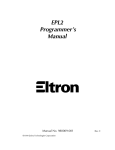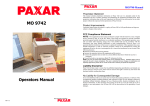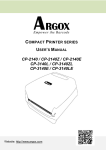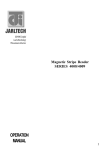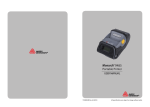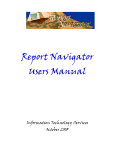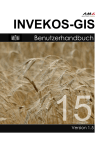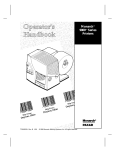Download Printer - Gomaro
Transcript
USER MANUAL
Model
9662
Printer
CONFIDENTIAL
Checking Your Box
Receiving the box of your printer, you are advised to
check first for the possible shipping damage. There are two ways you
can do it:
1. Inspect the outer appearances of both the box and the printer for
possible damage.
2. Raise the top cover of the printer to see if the media compartments
Printer
are in order.
If damages did occur, immediately file the claim to the shipping
company for settlement.
User's
Manual
Having performed the primary inspections, next step,
please check whether you have received the following accessories
together with the printer. If there is any item missing, contact your local
dealer to get it.
Power Cord
CD ROM
1
Ribbon
2
Power Supply
Setting up the Printer
Power Switch
Before setting up the printer you should first consider the following:
♦
AC Power Connector
Find a solid flat surface with adequate room for the printer. Make
sure there is enough room on the top side for the media and ribbon
access.
♦
The location should be near the host or terminal. Consider the
distance between host and printer for the communication cable
(serial or parallel cable)
♦
Clear the ground and isolate from other electrical cables for the
power adapter.
Connecting the Power Cord
1.
Leave the power switch at the ”O” position.
2.
Connect the power supply plug to the power jack and the other
Power Jack
end to your AC source.
AC Electrical Outlet
3
4
Parts and Features
Ribbon Pick-up Spindle
Ribbon Supply Spindle
Media Supply Spindle
LCD Display
Top Access Door
Feed Slot
Bracket
Thermal Print Head
Front Access Door
Thermal Print Head
Head Latch
Platen Roller
Paper Sensor
Guide
5
6
Rewinder
Loading the Ribbon
Notes:
Peeler
Sensor
1. This section is applicable to the transfer thermal printing.
2. Attached ribbon is coating inside.
1. Lift the top access door and the front access door to expose the
compartment. ( Figure 1 )
2. Push the head latch by anti-clockwise, and then fold the bracket.
( Figure 2 )
3. Unwrap the ribbon roll pack and separate the ribbon roll and the bare
core.
4. Insert the ribbon roll into the ribbon supply spindle. ( Figure 3 )
Peel Off Mode
5. Lead the bare core through the print head module. ( Figure 4 )
6. Attach the edge of the ribbon on the bare core and wind it a little bit
onto the core.
Note:
The dull side of the ribbon should be faced down.
7. Insert the bare core into the ribbon pick-up spindle. ( Figure 5 )
8. Turn the pick-up spindle to ensure the ribbon is tightly wound.
1
Cutter
Top Cover
Cutter Mode
Front Access
Door
7
8
4
2
Print Head Module
Bare Core
Head
Latch
Bracket
3
Ribbon Supply
Spindle
5
Ribbon Pick-up
Spindle
9
10
Loading the Media
6
Media Guide
9662 Series printers can be operated in three different options: standard,
peel-off, or with a cutter.
Standard mode allows you to collect each label freely.
In peel-off mode, the backing material is being peeled away from
the label as it is printed. After the former label is removed, the next
one will be printed.
In cutter mode, the printer automatically cuts the label after it is
printed.
Media Supply
Spindle
Standard Mode
1. Insert the media roll into the media supply spindle and move the
media guide to the inside. ( Figure 6 )
2. Push the head latch by anti-clockwise, and then fold the bracket.
3. Remove the outside media guide. ( Figure 7 )
7
Head Latch
1.Lead the Media through the print head module and under the paper
sensor guide. ( Figure 8 )
5. Put back the outside media guide, close the bracket, and buckle the
Outside Media
Guide
head latch. ( Figure 9 )
6. Close the top access door and the front access door and then turn
on the printer or press the “FEED” button if the printer is already on
( Figure 10 )
Bracket
11
12
8
Print Head
Module
Paper Sensor
Guide
9
Head Latch
Bracket
Outside Media Guide
13
14
Peel Off Mode
Follow the common procedure of “ Loading the Media “ of Standard
Mode from step 1 to 3.
11
4. Remove approximately 6” long labels from the label
backing paper. ( Figure 11 )
5. Lead the backing paper through the print head module. ( Figure 12 )
6. Turn back under the print head module. ( Figure 13 )
7. Use a sticker to fix the media on the rewinder kit.( Figure 14 )
8. Turn the rewinder kit twice to ensure the media is firmly fixed. ( Figure
15 )
9. Close the side access door and turn on the printer or press the FEED
button if the printer is already on. ( Figure 16 )
Notes:
1. The “ FEED “ button will not drive the printer to peel. The peeling work
Backing Paper
can be executed only when (1 ) the software setting is ready; (2) Bit 5
of DIP switch at rear panel must be set to ON position.
2. Please sure the peeler sensor is out of ribbon path when it’s installed.
Print Head Module
12
15
16
15
13
Rewinder Kit
Print Head Module
16
14
Sticker
Rewinder Kit
17
18
Cutter Mode
Follow the common procedure of “ Loading the Media “ of Standard
Mode from step 1 to 3.
Head
Latch
4. Insert the media into the print head module and under the paper
sensor guide. ( Figure 17 )
5. Put back the outside media guide, close the bracket, and buckle the
head latch. ( Figure 18 )
6. Close the top access door and turn on the printer or press the FEED
button if the printer is already on, and then the label will be fed into the
cutter mode automatically. ( Figure 19 )
Note:
The “ FEED “ button will not drive the printer to cut. The cutting work can
Bracket
be executed only when (1) the software setting is ready; (2) Bit 3 of DIP
Outside Media
Guide
18
switch at rear panel must be set to the ON position.
17
Paper Sensor Guide
Print Head Module
19
Cutter
19
20
Operator Controls
LED Indicators
Front Panel
There are three LED indicators on the front panel, “READY”, “MEDIA” and
“RIBBON”. These indicators display the operation status of the printer.
The front panel includes
-
3 LED indicators (READY, MEDIA and RIBBON)
-
3 buttons (FEED, PAUSE and CANCEL)
-
A LCD display
✸ READY
The READY indicator will remain lighted except if any of the
following conditions prevail.
- The printer is at PAUSE state.
- A fault condition
✸ MEDIA
The MEDIA indicator will remain on for the normal
operation of the printer.
Blinking – Media run out
✸ RIBBON
ONIII– under thermal transfer mode with ribbon installed.
OFF – under direct thermal mode. ( no ribbon installed )
Set by Windows driver or command.
Blinking – Ribbon run out
21
22
Buttons
LCD Display
There are three buttons, each having two basic functions.
Basic Functions :
Button
FEED
Under normal condition
Feeds a label.
Pressed the button and
-
to display the printer status
turn on the power
-
to display the printer settings
simultaneously
-
to display the input data from a keyboard or barcode
reader.
Performs a self test and a
configuration report will
PAUSE
be printed.
After power on the following
■ Stops the printing process.
Perform the media
message is displayed on the
■ Resume the printing after
calibration.
LCD.
Resets the settings at
The first parameter is either 203 or 300. It stands for the printer
E2PROM.
resolution. The second parameter indicates the emulation (printer
READY (203,MPCL)
press it again.
CANCEL
■ Interrupts and deletes the
printing task.
language), MPCL or PPLB.
■ Forces the printer to
continue working after an
error had been solved.
2.
READY (203,MPCL)
extra message will be shown
<ESC> FOR KEYBD
at the second row.
Notes:
1.
If a keyboard is plugged in,
We suggest you make “ media calibration “.
- after the first time installation
If a barcode reader is
READY (203,MPCL)
- after change different type or size of media
connected and bits 6 ~ 8 are
WITH B.C. READER
After calibration the printer will save the related parameters
all at ON positions, extra
(reflection characteristics, label length, etc.) to E PROM. Without
message will be shown at
correct calibration the gap detection is easily lost during printing
the second row.
2
especially for small labels (less than 1.5 inches in height).
3.
4.
23
Before calibration, the media and ribbon must be loaded properly
If any abnormal condition
and move the label sensor to correct position.
occurs the related message
After self-test, the printer is at dump mode, If you need normal
will be displayed. For
operation, you must press CANCEL to restart the printer.
example,
RIBBON OUT
24
Setting from Panel
Selection Items
You can change some settings from proper panel operation instead of
sending commands.
Item
Range
CUT/PEEL POS -15 ~ 15 mm
Factory Default
0 mm
(mm)
Buttons
Function
PRINT OFFSET
Controls cut and peeling
position.
-8 ~ 15 mm
PAUSE + CANCEL
Enters setting mode.
(Don’t press over 1
A second press will exit setting mode and return to
second)
normal mode.
TPH VER OFFS -3~3 mm
FEED
Pressing this button will show next parameter.
(mm)
PAUSE
Pressing this button will show next setting item.
RECOVERY
ENABLED,
CANCEL
Selects certain parameter and causes the
PRINT
DISABLED
parameter to be saved in the permanent memory
GAP HEIGHT
0 mm
(mm)
Controls vertical print
position. Positive value
only.
0 mm
Offset of vertical print
position
ENABLED
Contents reprint after
media-out or ribbon-out
MORE THAN 10 MORE THAN 10 This item appears only
(E2PROM).
mm,
Except you change it from either panel or
5 ~ 7 mm,
command the parameter will be kept even you
8 ~ 9 mm.
restart the printer.
Remarks
WIN CON LEN 0 ~ 254 mm
mm
when DIP switch bit 4 is at
ON position.
0 mm
(mm)
This takes effect only
when you run under
Procedure
Windows with bundled
Turn on the printer.
printer driver and use
1.
continuous media.
2.
Till “ READY” message is displayed on the LCD, press
[PAUSE]+[CANCEL] buttons simultaneously.
BASE SPEED
Press [PAUSE] button for several times to select the proper item that
(IPS)
0 ~ 4 IPS
0 IPS
This is for the PPLB
emulation only. When
you want to change the parameter.
you choose TLP2642/
3.
Press [FEED] button till the specified parameter appears.
3642 driver the speed is
4.
Press [CANCEL] button to save it. A “*” mark will appear at the last
limited under 2 ips. This
column.
makes printer to upgrade
5.
Press both [PAUSE] and [CANCEL] buttons at the same time, to
return to normal mode.
the speed.
COUNTER ON ENABLED,
LCD
DISABLED
Note:
MEDIA SENS.
REFLECTIVE
Do not make this operation during printing or communication.
TYPE
SEE-THROUGH
25
ENABLED
REFLECTIVE
Select the proper type by
the media
26
characteristics. Once you
The printer supports six languages, English, French, German, Italian,
change it make sure to
Spanish and Portuguese for LCD display.
make calibration before
CUTTER
CHECKED,
SIGNAL
IGNORED
BACK FEED
DISABLED,
CHECKED
printing.
To select the language
This item appears only
1.
when DIP switch bit 3 is at
2.
Hold both buttons for about 3 seconds.
ON position.
3.
Release buttons.
For general media, set it
4.
The language item will appear.
to “CHECKED” except for
LANGUAGE
thick media.
ENGLISH
10~40 mm
*
DISABLED
5.
ENABLED
BACK
Press PAUSE and CANCEL buttons at the same time.
0 mm
DISTANCE
This item appears only
when BACKFEED is
enabled.
6.
Press FEED button for next language.
Press CANCEL button to select or set the language for your
need.
Pressing PAUSE or PAUSE+CANCEL buttons exits setting and enters
normal mode.
Notes:
1.
To make sure the settings take effect you had better restart the
printer after changing them.
2.
3.
Item
LANGUAGE
Range
ENGLISH, FRENCH,
When you store graphics with compression in flash board, do not
GERMAN, ITALIAN,
use them under non-compression mode. They must be consistent.
SPANISH, PORTUGUESE.
Factory Default
ENGLISH
Before selecting the see-through sensor make sure the main board
version is 5.0 or later, otherwise it can not work.
Setting Display Language
27
28
Rear Panel
Printing Configuration Report
The rear panel includes
Performing the Self Test
-
An 8-bit DIP switch
-
A 36-pin parallel port
1.
Turn off the printer. Press and hold the FEED button.
-
A 9-pin RS-232 serial port
2.
Turn on the power.
-
A PS/2 keyboard connector
3.
When the message “SELF TESTING …” is displayed on the LCD and
-
A power switch and power connector
DIP Switch
PS/2 KB I/F
READY indicator blinks, release the button.
Centronics
4.
The printer will print out a configuration report.
5.
Finally the “READY” message is displayed and the READY indicator
stops blinking and lights up.
6.
The following information will be printed on this report.
RS-232
Serial Port
-
Font list
-
DIP switch settings
-
Hardware configuration and status
-
Label parameters
-
Firmware version
Note:
After self test the printer will enter character dump mode. For normal
Power Switch
operation press the CANCEL button to stop dump mode.
Power Connector
29
30
Printing Configuration Report
Performing the Self Test
Resetting the Printer to Factory
Default Settings
If you would like to reset the printer to its factory defaults after certain
commands have been sent or settings changed:
1.
Turn off the printer. Press and hold the FEED button.
2.
Turn on the power.
3.
When the message “SELF TESTING …” is displayed on the LCD and
1.
Turn off the printer. Press and hold the CANCEL button.
READY indicator blinks, release the button.
2.
Turn on the power.
4.
The printer will print out a configuration report.
3.
When the message “ E2PROM RESET …” is displayed on the LCD and
5.
Finally the “READY” message is displayed and the READY indicator
stops blinking and lights up.
6.
READY indicator blinks, release the button.
4.
5.
-
Finally the “READY” message is displayed and the READY indicator
stops blinking and lights up.
The following information will be printed on this report.
The following parameters automatically reset.
Font list
-
DIP switch settings
-
Label parameters
-
Hardware configuration and status
-
Heat(Darkness)
-
Label parameters
-
Speed
-
Firmware version
-
Symbol set (language)
-
Others for specific emulation
Note:
After self test the printer will enter character dump mode. For normal
Notes :
operation press the CANCEL button to stop dump mode.
1.
All settings stored in non-volatile E2PROM cannot be destroyed even
by turning the printer off.
31
2.
The settings of DIP switch can not be reset.
3.
It is necessary to perform label sensitivity calibration after resetting.
4.
The printed label count can not be reset.
32
Hooking up the Printer & Computer
Communicate with the Printer
Connecting the Printer to Your Host
Communicate with the Printer
1.
You can connect the printer with any standard Centronics cable to
The bundled printer driver can be applied to all the applications under
the parallel port of the host computer.
Windows 2000/98/95, and Windows NT. Through this driver you may run
any popular software applications e.g. MS-Word and print out the
2.
Alternatively you can connect the printer with a serial cable to the
contents by this label printer as long as they are for Windows.
RS232C port of your computer or terminal. (for PC compatibles, the
RS232C port is COM1, COM2 or COM3.)
Before installation
Note :
1.
Check the contents of the driver to ensure it is complete.
Using Centronics allows for a much higher communication speed than
2.
Make a backup copy of this driver.
the use of a serial.
3.
Read the README.TXT file for installation guide and change notices.
Centronics
PC
PC
RS232 Serial
Port
33
34
Installing Driver
Notes:
1.
level of ‘Administrator'.
If you are just updating your driver, make sure to delete the previous
version first.
Note: Before installation, please make sure your “user’s right” is up tothe
2.
If you install a new bar code application software like ArgoBar,
LabelLView or CodeSoft, the Label Dr. 200 (or Label Dr. 300) driver
1.
Click the “Start” button.
2.
Select “Setting”, then select “Printers” and double click the “Add
should be activated and set as the current printer driver:
Printer” icon. Click “Next”.
ArgoBar
3.
click the “Network” or “Local” button and click the “Next” button.
File
4.
Click “Have Disk”, click the pull-down menu to select CD ROM
driver path.
LabelView
5.
click “Browse” button.
File
6.
Select the proper directory for installation:
New
Select Printer
Select Printer
-WIN95
CodeSoft
-WIN98
File
Printer
Label Dr. on LPT1:
Label Dr. on LPT1:
Windows
OK
OK
Label Dr. on LPT1:
OK
-WIN2000
-NT4.0
LabelMatrix
.
file
Printer Setup
Label Dr. on LPT1:
OK
.
.
7.
The driver name “Label Dr. 200” (6 inch model)or” Label Dr.300” (6
inch model)will appear in the “List of Printers”, select and click
“Next”.
8.
Select “Replace Existing Driver”.
9.
Select the communication port for the label printer. For parallel
port, select “LPT1:”, “LPT2:” or “LPT3:”, for serial port select “COM1:”
or “COM2:”.
10. After the related files have been copied to your system, the
installation is complete.
11. If you need to print from the label printer, set “Label Dr. 200” (or
Label Dr. 300) as the Default Printer.
35
36
Set the Parameters
For Win 98
After installing the driver, you can follow the path below to set
parameters:
Start
Settings
Printers
Label Dr.
Properties
Ports
Properties menu
click “Details”
select the IO port
The parameters include:
Ports Select the IO port to link with the printer.
The port may be one of
click “OK”
parallel (LPT), serial (COM), net work port or file.
Paper size Select the proper size on the menu. If there is no desired
size, select “Custom” (only in Win98/95/Me) to define the paper size.
Create a new size
Define paper size in Win 2000/NT4.0.
Orientation Set portrait or landscape according to the print
direction.
Paper source (Media type) T/T stands for thermal transfer
(ribbon) mode and D/T for direct thermal mode (without ribbon).
Paper size
Orientation
Media choice (Darkness) Set the heat value or darkness from
this field. The darkness value ranges from 0 to 15.
Paper source
Copies This function designates the number of printed copies of each
page.
More option (Accessory setting) To use the cutter and peeler
function you still need to enter More Options and select one of the items.
(Set DIP Switch also).
Device options (Speed) Set the printer speed. The speed ranges
from 1 to 6 IPS.
37
(Media type)
Media choice
(Darkness)
Copies
Properties menu
click "Paper"
click each item to
select desired
parameter
click "OK".
38
Output bin
(Accessory setting)
Properties menu
click "Paper"
click "more option"
select Enable/without
cutter, peeler
Create User-Define
Paper
Properties menu
click "Paper"
select "Custom"
User-Define size
set up a new size
click "OK"
click "OK"
Print quality
(Speed)
Properties menu
click "Device Options"
select parameters
click "OK"
39
40
Orientation
For Win 2000
Ports
Properties menu
click "Ports"
Printing Reference menu
click "Layout"
select "Portrait" or
"Landscape"
click "OK"
select the IO port
click "OK"
Paper size
Copies
Media choice
(Accessory setting)
Paper source
(Media type)
Back to Printers menu
Label Dr.
right click to get
pop-up menu
select "Printing
Reference"
click "Paper Quality"
select media type
Paper/Output
(Speed)
Print quality
(Darkness)
Printing Reference menu
click "Layout"
click "Advanced" button
click each item to select
the parameters
click "OK"
click "OK"
41
42
Create a new size
For NT 4.0
Printer menu
right click to get pop-up
menu in blank space
Ports
Properties menu
select "Server Properties"
click "Ports"
enter a form name for
select the IO port
the new form in "Form
click "OK"
description for"
reset the paper size in
the specific squares of
the "Measurements"
click "OK"
Paper size
Orientation
Paper source
(Media type)
Copies
Media choice
(Accessory setting)
Printers menu
Label Dr.
right click to get pop-up
menu
select "Document
Defaults"
click "Advanced" button
click each item to select
desired parameter
43
44
Paper/Output
Troubleshooting
(Speed)
Generally, when a malfunction or an abnormal condition occurs, the
Print quality
“READY” LED will keep blinking and printing and communication
(Darkness)
between the host and printer will stop.
Default Document menu
click "Advanced"
click each item to
To understand what the problem, please check the
LEDs and LCD display on the front panel first:
select desired
parameter
A. Problems on media
click "OK"
Create a new size
Blinking Indicators
READYand MEDIA
LCD display
MEDIA OUT
Please refer to the
procedure of create a
new size on Win 2000.
Possible Problems
Solutions
Remarks
Missing gap
. Check the media
If you use continuous
path
media, check your
. Check the position of application soft ware
label sensor.
and driver.
You should select
continuous.
Media out
. Supply the media roll
Media not installed
. Install the media roll
Media jam
. Recover the jam
If everything is OK try to make the label sensor calibration.( Refer to P30)
45
46
B. Problems on ribbon
MEMORY FULL
. Check the graphics and soft fonts
fromhost.
Blinking Indicators
READY and RIBBON
LCD display
RIBBON OUT
. Make sure to delete the graphics
and soft fonts if they are no longer
used bythe application software.
Possible Problems
Solutions
Remarks
(Refer to the Technical Rference
Ribbon has run out
Supply the ribbon roll
Does not apply to direct
Manual for details).
thermal. If you use direct
Ribbon jam
Recover the jam
Ribbon sensor error Replace the ribbon
sensor
thermal, set bit 1 of DIP
Note:
switch to OFF.
After the problems have been solved, press CANCEL to continue printing.
not for direct thermal.
not for direct thermal.
♦
C. Other Problems
Blinking Indicators
LCD display
D. Miscellaneous
1.
READY
Possible Problems and Solutions
SERIAL IO ERROR . Inconsistent baud rate, format or
protocol between host and
connector on the printer ?
Remarks
2.
not for
‘1’ and the power LED is still not illuminated, call for service.
♦
Refer to section 2 for DIP switch.
. Check the media
For X-2000+
. Check the connection between
and X-3000+
. Call for service.
DIP switch bit 3
Is the printer power turned on ?
If the power cord is connected, the power switch is at position
Centronics
. Check bits 6 ~ 8 of DIP switch.
cutter and main board.
Is the communication cable (parallel or serial) connected
securely to your parallel or serial port on the PC and to the
printer
CUTTER FAILED
The host shows “Printer Time out” .。
The data has been sent, but there is no output from the printer.
Check the active printer driver, it should be Label Dr. for your
Windows system and the label printer.
Check the emulation and the print (command) file.
should be ON
for cutter.
47
48
♦
Vertical streaks in the printout usually indicate a dirty or faulty print
head. Clean the print head first, if they still persist, replace the print
Addendum
head.
If you use small labels ( label height is less than 30 mm ) and the area
near top is unprintable you can adjust the top margin slightly by the
following procedure.
1. Hold FEED ( or PAUSE ) button and count the blink times for READY
LED. Each blink stands for 1 pixel. For 0.5 mm you need 4 blinks.
2. Release the button.
3. Restart the printer.
4. Send data to printer to print again.
5. Check the print position.
♦
Unstable ribbon roll rotation.
Check the label path and make sure the head latch is securely
If you make calibration again the slight adjustment will be reset.
closed.
♦
Poor printout quality.
. The ribbon may be not qualified.
. The media may be not qualified.
. Adjust the Darkness (heat temperature).
. Slow down the print speed.
. Refer to the following paragraphs and clear the related modules.
Recovery
In order to continue your print jobs after any abnormal conditions have
been recovered, simply press the CANCEL button or restart the printer.
Make sure that the LED indicator is illuminated and not blinking and
remember to resend your files.
49
50
Caring for your Printer
Reference Technical Information
Before maintenance be sure to turn off the printer power.
1. General Specification
1. Cleaning the print head(TPH)
Model 9662
Specification
Print method
Direct thermal and thermal transfer
Turn off the printer, open the cover, print head module and remove
Resolution
203 DPI ( 8 dots/mm)
the ribbon. Rub the print head with a piece of cotton which has
Printing width
Max 6.3” (160 mm), Max 6” (152mm) in cutter mode.
been moistened with alcohol. Check for any traces of black
Printing length
1” ~ 30” (25mm ~ 1143mm)
coloring or adhesive on the cotton after cleaning. Repeat if
Printing speed
2~6 ips (51~152 mm/s)
necessary until the cotton is clean after it is passed over the head.
Memory
2Mb DRAM, 1Mb Flash ROM
CPU type
32 bit RISC Microprocessor
Media sensor
Reflective and see-though Transmissive
Note :
The print head should be cleaned at least every time the ribbon is
replaced and more often depending on actual usage and conditions.
2. Cleaning the roller
Using a cotton moistened with alcohol, clean the roll and rip off the
attached glue.
Note :
The roller should be cleaned whenever it has been in contact with
foreign materials such as dust or adhesives.
3. Cleaning the media compartment
Clean the media compartment with cotton which has been
moistened with a mild detergent. Every time a media roll is printed
this compartment should be cleaned to reduce the incidence dust.
Display
LCD display, 2-lineX16, LED indicators X 3
Communication
Centronics parallel, RS-232 serial
interface
Maximum label
8 in.(203 mm) outside diameter
roll diameter
1.5 in. ~ 3.0 in.(38 mm ~ 76 mm) inside diameter
Media type
Roll-feed, die-cut, continuous, fan-fold, tags, ticket in
thermal paper or plain paper.
Label indexing
Black stripe and gap
Ribbon types
Wax, Wax/resin and Resin ; Coating inside
Ribbon size
OD 2.5 in. (63mm)
ID 1 in. (25 mm)
Compact size
W12.1” ╳ H10.2” ╳ L17.3” (W310╳ H260╳ L445 mm)
Weight
32Ibs ( 14.5kg )
Power source
110/220 VAC + 10%, 50/60 Hz
Agency listing
CE, UL, CUL, FCC class A
Operating
40° ~ 100°F (4° ~ 38°C)
temperature
10~90% non condensing
Storage
-40°F ~ 140°F (-4°C ~ 60°C)
temperature
51
52
Windows driver
for Win 3.11, 95, 98, 2000 and NT
The specifications of fonts, bar codes and graphics depend on the
Printer emulation
PPLA
printer emulation. The emulation is a printer programming language,
Optional
♦ Serial (RS232) cable
through which the host can communicate with your printer. There are
Accessories
♦ Dispenser
two printer programming languages for all models 9662, they are
♦ Cutter
MPCL and PPL.
♦ Flash memory
♦ Font board
Printer Programming Language A, PPL
♦ Standalone KDU – ArgoKee
♦ USB interface
♦ Printer server – ArgoNet
( for Ethernet connection )
Specification
G-6000
General fonts
7 alpha-numeric fonts, OCR A and OCR B
ASD smooth fonts
6, 8, 10, 12, 14 and 18 points
Symbol sets for
USASCII, UK, German, French, Italian, Spanish,
Note:
smooth fonts
Swedish, and Danish/Norwegian
The font board and flash memory board cannot be
Courier fonts
installed simultaneously.
8 symbol sets (PC, PC-A, PC-B, EAMA-94,
Roman ,Legal, Greek and Russian)
Soft fonts
Downloadable PCL fonts
Font expandability 1x1 to 24x24
Bar code types
Code 39, Code 93, Code 128/subset A,B,C,
Codabar, Interleave 2 of 5, UPC A/E/2 and 5
add-on, EAN-8/13, UCC/EAN-128, Postnet, Plessey,
HBIC, Telepen and FIM.
MaxiCode PDF417 and DataMatrix (2D symbologies).
Graphics
PCX, BMP, IMG and HEX formats
Stand-alone
operation without
ArgoKee
host
2. Fonts, Bar Codes and Graphics Specification
3. Interface Specifications
Introduction
53
54
Connection with host:
This appendix presents the interface specifications of IO ports for the
printer. These specifications include pin assignments, protocols and
detailed information about how to properly interface your printer with
Host 25S
Printer 9P
(PC or compatible)
Host 9S
Printer 9P
(PC or compatible)
your host or terminal.
Serial
The RS232 connector on the printer side is a female, DB-9.
Pin
Direction
Definition
1
In
DSR
2
In
RxData
3
Out
TxData
5
-
Ground
6
Out
DTR
7
Out
RTS
8
In
CTS
9
Out
+5V
Note :
Pin 9 is reserved for KDU(keyboard device unit) only, therefore do not
connect this pin if you are using a general host like a PC.
55
DTR 20
DSR 6
TX 2
RX 3
CTS 5
RTS 4
GND 7
………..
………..
………..
………..
………..
………..
………..
1 DSR
6 DTR
2 RX
3 TX
7 RTS
8 CTR
5 GND
DTR 4
DSR 6
TX 3
RX 2
CTS 8
RTS 7
GND 5
………..
………..
………..
………..
………..
………..
………..
1 DSR
6 DTR
2 RX
3 TX
7 RTS
8 CTS
5 GND
Alternatively you can just connect the 3 wires in the following way.
Host 25S
Printer 9P
(PC or compatible)
TX 2 ……….. 2 RX
RX 3 ……….. 3 TX
GND 7 ……….. 5 GND
pin 4
pin 5
pin 6
pin 20
Host 9S
Printer 9P
(PC or compatible)
TX 3 ……….. 2 RX
RX 2 ……….. 3 TX
GND 5 ……….. 5 GND
pin 4
pin 6
pin 7
pin 8
56
The most simple way to connect to other hosts(not PC compatible) or
Parallel (Centronics)
terminals is:
The parallel port is a standard 36-pin Centronics. Its pin assignments are
Printer
Pin 2- RxData
Pin 3- TxData
Pin 5- Ground
Terminal/Host
………… TxData
………… RxData
………… Ground
listed as following.
Pin
Direction Definition
Pin
Direction
Definition
1
In
/STROBE
13
Out
SELECT
2
In
Data 1
14,15
In general as long as the data quantity is not too large or you use
3
In
Data 2
16
-
Ground
Xon/Xoff as flow control, there will be no problem at all.
4
In
Data 3
17
-
Ground
5
In
Data 4
18
NC
6
In
Data 5
19~30 -
Ground
NC
Baud rate: 2400, 4800, 9600, 19200 and 38400.
(set from bits 6 ~ 8 of DIP switch)
Data format: always 8 data bits, 1 start bit and 1 stop bit.
Parity : always non parity
Handshaking : XON/XOFF as well as CTS/RTS (hardware flow control).
If you run an application with the bundled printer driver under Windows
and use the serial port, you should check the above parameters and set
the flow control to “Xon/Xoff” or “hardware”.
NC
7
In
Data 6
31
8
In
Data 7
32
9
In
Data 8
33~36 -
10
Out
/ACK
11
Out
BUSY
12
Out
PE
Out
/Fault
NC
Auto Polling
Both the serial and parallel ports are active at the same time on this
printer, i.e. data can be received on either one, however no provision is
made for port contention. If data is transmitted to both ports
simultaneously, it will cause the data in the received buffer to be
corrupted.
57
58
Appendix A: Printer Status
4. ASCII TABLE
0
0 NUL
1 SOH
2 STX
3
4
5
6 ACK
7 BEL
8 BS
9
A LF
B
C FF
D CR
E SO
F SI
1
2
XON
!
“
#
$
%
&
‘
(
)
*
+
,
.
/
XOFF
NAK
ESC
RS
US
3
0
1
2
3
4
5
6
7
8
9
:
;
<
=
>
?
4
@
A
B
C
D
E
F
G
H
I
J
K
L
M
N
O
5
P
Q
R
S
T
U
V
W
X
Y
Z
[
\
]
^
_
6
`
a
b
c
d
e
f
g
h
i
j
k
l
m
n
o
7
p
q
r
s
t
u
v
w
x
y
z
{
|
}
~
DEL
LCD display
Blinking LED
Description
PAUSE
READY
The printer is at pause state. Press
PAUSE or CANCEL to return to normal
state.
MEDIA OUT
RIBBON OUT
MEDIA
The media is uninstalled or used up.
READY
Load new media to the printer.
RIBBON
The ribbon is uninstalled or
READY
end-of-ribbon occurred. Load new
ribbon to the printer. If you just use
thermal media set bit 1 of DIP switch
to OFF position.
SERIAL IO ERROR
READY
The format or baud rate of the RS232
communication is inconsistent
between the printer and host.
CUTTER FAILED
READY
The cutter can not cut off the media,
MEMORY FULL
READY
The printer buffer is full caused by the
check the media and cutter.
loaded soft fonts, graphics or forms.
Check the format of these data. Call
for service.
HEAD OPEN
READY
The print head latch is not closed. To
print the label the head latch must be
closed.
P. SENSOR O.R.
READY
The media sensor is out of range
during calibration. Make sure the
media is installed and the label sensor
is put under the media.
59
60
Appendix B:
6. Loosen two screws (4) from bracket (5).
INSTALLATION FOR CUTTER
1. Turn off the printer
2. Remove the top covers on both left and right sides.
3. Mount the cutter IC to U22 on main board; Take care of the location
and direction, the IC hole ix at lower Position.
4. Set bit 3 of DIP switch (1~8) to ON position.
5. Secure two screws for cutter (1) and bracket (2).
Note:
The drive IC for cutter is 3770.
,
7. Insert the left side of cutter bracket (7) and secure two screws (6) to
the TPH module.
61
62
8. Thread the cutter cable through a hole (8) and route it to JP13
connector(CUTTER).
After the cutter is installed, install media and ribbon.
Appendix C:
INSTALLATION for
DISPENSER and REWINDER
1. Turn off the printer.
2. Remove the top covers on both left and right sides.
1. Put the media end on the roller.
3. Set bit 5 of DIP switch (1~8) to ON position.
2. Close the TPH latch.
4. Refer to the diagram. Assemble the related components for both left
3. Hold the PAUSE/CALIBR button and turn on the Printer.
and right sides.
4. Release the button when the cutter starts cutting.
5. After cutting the Printer will feed the label for 12 inches.
Notes:
The above procedure is taken at first time after installation or cutter jam.
Normally the Procedure is
1. Put the media end on the roller.
2. Close the TPH latch.
3. Turn on the printer.
4. Press the FEED button to let the media end go through the cutter.
63
64
5. Connect the dispenser sensor to JP12 (LABEL) of main board and
secure the dispenser board in front of TPH module.
Adjustment
The plastic core (13,14) of the rewinder kit must be parallel with the exit
media or label. To adjust the position you may
• remove the screw (13), tune the position of component (14), or
• loosen the two screws (15 and 16), shift the position of metal bar and
secure the screws.
6. Install ribbon and media.
65
66
Calibration for Dispenser Sensor
If you find the sensor is not so sensitive or mis –detection you can send
two commands to calibrate it.
Command
Binary
Remark33 33
Set sensor without label <ESC>$R0
ASCII
1BH 24H 52H 30H
Command 0
Set sensor with label
1BH 24H 52H 31H
Command 1
<ESC>$R1
Step 1. Put the label away from the sensor, send command 0 and wait
for 2 more seconds.
Step 2.
Put a label under the sensor (10 mm below), hold it, send
command 1 and wait for 2 more seconds.
67



































